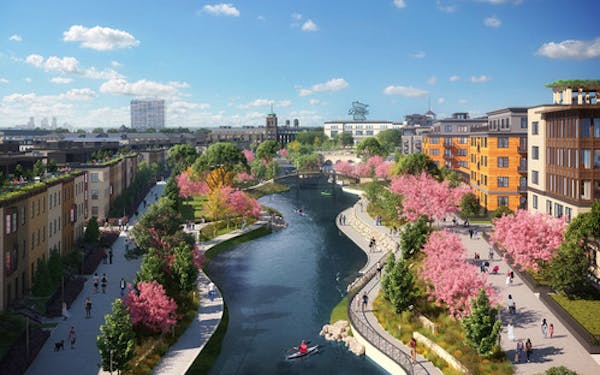More than a century ago, a stream in St. Paul's Highland Park carried stormwater from higher ground over Hidden Falls. On Monday, work began to once again feed those falls with a steady flow gathered from the 122-acre former Ford manufacturing site, now known as Highland Bridge.
Through the summer, workers will build a tunnel beneath Mississippi River Boulevard that will allow runoff from a wide swath to reach the falls. This time, instead of a natural stream, a collection system resembling small ponds and a winding river will do the work.
Work at St. Paul's old Ford site will reroute stormwater to Hidden Falls. | Star Tribune
In addition to its aesthetic and recreational benefits to what will be St. Paul's newest mixed-use development, the system now taking shape will filter pollutants year-round before returning stormwater to the Mississippi below.
Much of the system's stream path has been built and is receiving finishing touches before the water starts to flow later this month, Ryan Cos. officials said. On Monday, excavators, cranes and dump trucks moved loudly through the site.
"Ultimately, everything that comes off the site will be collected and treated before going to the river," said Nick Koch, who is overseeing construction for Ryan Cos., the site's master developer.
A portion of Mississippi River Boulevard and its trails will be closed through fall as the tunnel is built.
After Henry Ford's factory was built early in the 20th century, stormwater was ingloriously routed through buried pipes to pour untreated and unwatched into the river.
Officials at the Capitol Region Watershed District floated the idea of restoring a stream years ago. Ryan's developers embraced the idea.
Using public and private money, Ryan will spend more than $92 million creating a street grid and utilities throughout the development. The public share — approved by the St. Paul City Council more than a year ago — is $53 million. Millions more in public money, through tax-increment financing, has been committed to help build affordable housing.
Through a series of underground tanks, surface ponds, manufactured wetlands and the stream-like water feature — designed to hold 3 to 7 feet of water — the stormwater collection system isn't expected to run dry during drought nor get overwhelmed by torrential rains, said Josh Ekstrand, Ryan's national director of design.
Officials said the system is expected to improve area water quality by capturing 94% of total suspended solids and improve the capture of phosphorus by 75%.
The system is also designed to serve as a year-round amenity that can host kayakers and paddle-boarders in summer and ice skaters in winter. Visitors will find fountains in a public plaza off Ford Parkway and walking and bike trails along the stream.
"We think it is a great opportunity for people not only in the neighborhood, but in the broader community as well, to have recreation on the water," said Maureen Michalski, vice president of real estate development for Ryan.
Many of the project's 320 planned row houses, with prices well north of $300,000, will be oriented to give residents a view of the water.
Said Ekstrand: "There will be ways to experience the water, all the way up at street level to down at the water's edge and everything in between. So there's places to sit, places to walk, places to bike and places to hang out. And as more residential units get built around it, the community will become even more vibrant."

Fired Mpls. teacher accuses management of 'cancerous rot'

Jill Biden rallies women, teachers for the Biden-Harris ticket in Bloomington speeches
Neighbors, city officials at odds over Rochester lake dam

Souhan: This is KAT's chance to prove Flip Saunders was right

